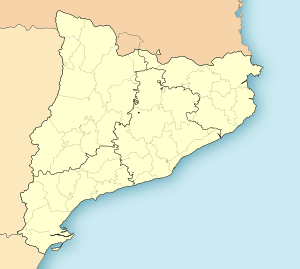| 2017 Barcelona attacks | |
|---|---|
| Part of Islamic terrorism in Europe | |
 La Rambla, the site of the van attack; pictured in 2011 | |
| Location | La Rambla, Barcelona and Cambrils, Catalonia, Spain |
| Coordinates | La Rambla: 41°22′53″N 2°10′23″E / 41.38139°N 2.17306°E Cambrils: 41°22′53″N 2°10′23″E / 41.38139°N 2.17306°E Alcanar: 40°34′51″N 0°33′11″E / 40.580919°N 0.553046°E Subirats: 41°23′05″N 1°47′53″E / 41.384722°N 1.798056°E |
| Date | 17–18 August 2017 16:54–01:15 CEST (UTC+2) |
| Target | Pedestrians |
Attack type | Vehicle-ramming attack, stabbing, mass murder |
| Weapons | Alcanar: TATP, Gas cylinders (accidental[1] explosion) Barcelona: A van and a knife Cambrils: A car and a knife |
| Deaths | 24 (16 civilians, 8 terrorists) |
| Injured | 152 |
| Perpetrator | |
No. of participants | 8 |
| Motive | Jihadism |
On the afternoon of 17 August 2017, 22-year-old Younes Abouyaaqoub drove a van into pedestrians on La Rambla street in Barcelona, Catalonia, Spain killing 13 people and injuring at least 130 others, one of whom died 10 days later on 27 August. Abouyaaqoub fled the attack on foot, then killed another person in order to steal the victim's car to make his escape.[2][3][4]
Nine hours after the Barcelona attack, five men thought to be members of the same terrorist cell drove into pedestrians in nearby Cambrils, killing one woman and injuring six others. All five of those attackers were shot and killed by police.[5]
The night before the Barcelona attack, an explosion occurred in a house in the Catalan town of Alcanar, destroying the building and killing two members of the terrorist cell, including the 40-year-old imam thought to be the mastermind.[6] The home had more than 120 gas canisters inside which police believe the cell was attempting to make into one large bomb (or three smaller bombs to be placed in three vans that they had rented) but which they accidentally detonated.[7][4]
The Prime Minister of Spain, Mariano Rajoy, called the attack in Barcelona a jihadist attack.[8] Amaq News Agency attributed indirect responsibility for the attack to the Islamic State.[9] The attacks were the deadliest in Spain since the March 2004 Madrid train bombings and the deadliest in Barcelona since the 1987 Hipercor bombing.[10] Younes Abouyaaqoub, the driver of the van in the Barcelona attack, was killed by police in Subirats, a town 31 kilometres (19 mi) west of Barcelona on 21 August.[4]
A 2022 statement by former Spanish police commissioner José Manuel Villarejo appeared to suggest in the Spanish High Court that the Spanish National Intelligence Service was aware of the attacks.[11][12] Others have dismissed this statement as a conspiracy theory.[13]
- ^ "Source: Early assessment finds TATP at Barcelona attackers' bomb factory". CNN. 18 August 2017. Retrieved 18 August 2017.
- ^ "Spain attack: What do we know about the victims?". BBC News. 21 August 2017. Retrieved 22 August 2017.
- ^ "Barcelona attack suspect 'hijacked car to escape'". BBC. Retrieved 22 August 2017.
- ^ a b c "Barcelona attack: four suspects to face court after van driver is shot dead". The Guardian. Retrieved 22 August 2017.
- ^ "Cambrils: five terror suspects killed as second attack follows Las Ramblas". The Guardian. BBCwww. 18 August 2017.
- ^ "Atentado en Barcelona – Los Mossos confirman que el imam de Ripoll murió mientras manipulaba explosivos" [Attack in Barcelona – The Mossos confirm that the imam of Ripoll died while manipulating explosives] (in Spanish). 21 August 2017 – via El Mundo.
- ^ "Barcelona attack: Spain terror cell had 120 gas canisters". BBC. 20 August 2017.
- ^ "Barcelona and Cambrils: 'Bigger' attacks were prepared". BBCwww. 18 August 2017.
- ^ "Van crashes into dozens of people in Barcelona: police". Reuters. Retrieved 17 August 2017.
- ^ Cite error: The named reference
ecowas invoked but never defined (see the help page). - ^ "Villarejo claims that Spain's intel was involved in the Barcelona terrorist attack of 2017". VilaWeb (in Catalan). Retrieved 13 January 2022.
- ^ Madrid, Guy Hedgecoe in. "Rogue police officer's claim about Barcelona terror strike triggers anger". The Irish Times. Retrieved 17 January 2022.
- ^ Cite error: The named reference
:3was invoked but never defined (see the help page).
